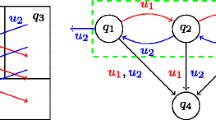Abstract
The development of formal methods for control design is an important challenge with potential applications in a wide range of safety-critical cyber-physical systems. Focusing on switched dynamical systems, we propose a new abstraction, based on time-varying regions of invariance (control funnels), that models behaviors of systems as timed automata. The main advantage of this method is that it allows for the automated verification and reactive controller synthesis without discretizing the evolution of the state of the system. Efficient and analytic constructions are possible in the case of linear dynamics whereas bounding funnels with conjectured properties based on numerical simulations can be used for general nonlinear dynamics. We demonstrate the potential of our approach with three examples.















Similar content being viewed by others
Notes
In this paper, we mostly consider state spaces that describe the position and velocity of systems controlled in acceleration. The continuity of trajectories in the state space ensures that the position is always a continuously differentiable function of time.
One should always choose the reference trajectory such that there exists a margin between the reference values and the limit imposed by (8) since otherwise the convergence is very slow.
References
Alur R, Dill DL (1994) A theory of timed automata. Theor Comput Sci 126(2):183–235
Asarin E, Maler O, Pnueli A (1995) Reachability analysis of dynamical systems having piecewise-constant derivatives. Theor Comput Sci 138(1):35–65
Asarin E, Maler O, Pnueli A, Sifakis J (1998) Controller synthesis for timed automata. In: IEEE SSSC’98. Elsevier, New York, pp 469–474
Aubin JP (1988) Viability tubes. In: Modelling and adaptive control. Springer, New York, pp. 27–47
Behrmann G, David A, Larsen KG, Håkansson J, Pettersson P, Yi W, Hendriks M (2006) Uppaal 4.0. In: IEEE quantitative evaluation of systems (QEST’06), pp. 125–126
Behrmann G, Cougnard A, David A, Fleury E, Larsen KG, Lime D (2007) UPPAAL-Tiga: time for playing games! In: International conference on computer aided verification (CAV’07). Lecture notes in computer science, vol. 4590. Springer, New York, pp. 121–125
Bouyer P, Dufourd C, Fleury E, Petit A (2004) Updatable timed automata. Theor Comput Sci 321(2–3):291–345
Bouyer P, Fahrenberg U, Larsen KG, Markey N (2011) Quantitative analysis of real-time systems using priced timed automata. Commun ACM 54(9):78–87
Bouyer P, Markey N, Perrin N, Schlehuber-Caissier P (2015) Timed-automata abstraction of switched dynamical systems using control funnels. In: FORMATS’15. Lecture notes in computer science, vol. 9268. Springer, New York, pp. 60–75
David, A, Grunnet JD, Jessen JJ, Larsen KG, Rasmussen JI (2012) Application of model-checking technology to controller synthesis. In: IEEE formal methods and models for co-design (FMCO’10). Lecture notes in computer science, vol. 6957. Springer, New York, pp. 336–351
DeCastro J, Kress-Gazit H (2014) Synthesis of nonlinear continuous controllers for verifiably-correct high-level, reactive behaviors. IJRR 34(3):378–394
Duggirala PS, Mitra S, Viswanathan M (2013) Verification of annotated models from executions. In: IEEE international conference on embedded software (EMSOFT’13), pp 1–10
Frazzoli E, Dahleh MA, Feron E (2005) Maneuver-based motion planning for nonlinear systems with symmetries. IEEE Trans Robot 21(6):1077–1091
Fu J, Topcu U (2015) Computational methods for stochastic control with metric interval temporal logic specifications. Tech. Rep. arXiv:1503.07193
Julius AA, Pappas GJ (2009) Trajectory based verification using local finite-time invariance. In: International conference on hybrid systems: computation and control (HSCC’09). Lecture notes in computer science, vol. 5469. Springer, New York, pp 223–236
Koiran P, Cosnard M, Garzon M (1994) Computability with low-dimensional dynamical systems. Theor Comput Sci 132(1):113–128
Le Ny JL, Pappas GJ (2012) Sequential composition of robust controller specifications. In: IEEE international conference on robotics and automation (ICRA’12), pp. 5190–5195
Liu J, Prabhakar P (2014) Switching control of dynamical systems from metric temporal logic specifications. In: IEEE international conference on robotics and automation (ICRA’14), pp. 5333–5338
Majumdar A, Ahmadi AA, Tedrake R (2013) Control design along trajectories with sums of squares programming. In: IEEE international conference on robotics and automation (ICRA’13), pp. 4054–4061
Majumdar A, Tedrake R (2013) Robust online motion planning with regions of finite time invariance. In: International workshop on the algorithmic foundations of robotics (WAFR’12). STAR, vol 86. Springer, New York, pp 543–558
Maler O, Batt G (2008) Approximating continuous systems by timed automata. In: Proceedings of formal methods in systems biology (FMSB’08). LNBI, vol 5054. Springer, New York, pp. 77–89
Maler O, Manna Z, Pnueli A (1992) From timed to hybrid systems. In: Real-time: theory in practice. Lecture notes in computer science, vol 600. Springer, New York, pp 447–484
Mason MT (1985) The mechanics of manipulation. In: IEEE international conference on robotics and automation (ICRA’85), vol 2, pp 544–548
Prajna S, Papachristodoulou A, Wu F (2004) Nonlinear control synthesis by sum of squares optimization: a Lyapunov-based approach. In: 5th Asian IEEE control conference, vol 1, pp 157–165
Quottrup MM, Bak T, Zamanabadi RI (2004) Multi-robot planning : a timed automata approach. In: IEEE international conference on robotics and automation (ICRA’04), vol 5, pp 4417–4422
Sloth C, Wisniewski R (2010) Timed game abstraction of control systems. Tech. Rep. arXiv:1012.5113
Sloth C, Wisniewski R (2013) Complete abstractions of dynamical systems by timed automata. Nonlinear Anal 7(1):80–100
Sontag ED (1998) Mathematical control theory: deterministic finite dimensional systems. Springer, New York
Tedrake R, Manchester IR, Tobenkin M, Roberts JW (2010) LQR-trees: feedback motion planning via sums-of-squares verification. IJRR 29(8):1038–1052
Acknowledgements
This work has been partly supported by ERC Starting Grant EQualIS (FP7-308087) and by European FET Project Cassting (FP7-601148).
Author information
Authors and Affiliations
Corresponding author
Rights and permissions
About this article
Cite this article
Bouyer, P., Markey, N., Perrin, N. et al. Timed-automata abstraction of switched dynamical systems using control invariants. Real-Time Syst 53, 327–353 (2017). https://doi.org/10.1007/s11241-016-9262-3
Published:
Issue Date:
DOI: https://doi.org/10.1007/s11241-016-9262-3




